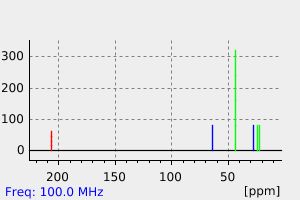bicyclo[2.2.2]octane-2,6-dione | 38231-60-6
中文名称
——
中文别名
——
英文名称
bicyclo[2.2.2]octane-2,6-dione
英文别名
Bicyclo[2.2.2]octan-2,6-dion
CAS
38231-60-6
化学式
C8H10O2
mdl
——
分子量
138.166
InChiKey
VXBMHPUAHFEJAV-UHFFFAOYSA-N
BEILSTEIN
——
EINECS
——
-
物化性质
-
计算性质
-
ADMET
-
安全信息
-
SDS
-
制备方法与用途
-
上下游信息
-
文献信息
-
表征谱图
-
同类化合物
-
相关功能分类
-
相关结构分类
计算性质
-
辛醇/水分配系数(LogP):0.6
-
重原子数:10
-
可旋转键数:0
-
环数:3.0
-
sp3杂化的碳原子比例:0.75
-
拓扑面积:34.1
-
氢给体数:0
-
氢受体数:2
上下游信息
反应信息
-
作为反应物:描述:bicyclo[2.2.2]octane-2,6-dione 在 硫酸 、 6-oxocamphor hydrolase from Rhodococcus sp. 作用下, 以 aq. phosphate buffer 为溶剂, 反应 1.0h, 生成 (S)-(-)-methyl 3-oxocyclohexylacetate参考文献:名称:通过三步生物催化步骤从前手性二酮不对称合成3-取代的环己胺衍生物摘要:前手性双环二酮通过三个连续的生物催化步骤转化为3个取代的环己胺衍生物的单一非对映异构体。的两个手性中心通过一个C设置在第一步骤C中水解酶(6-oxocamphor水解酶),并通过在最后步骤中的ω转氨酶。如果可能的话,在第二步中,通过脂肪酶催化中间体酮酸的酯化反应。对于两个基板,CC水解步骤和酯化反应可以在有机溶剂中的一锅级联反应中同时进行。在一个示例中,可以将前两步的反应混合物直接在有机溶剂中进行生物胺化反应,而无需更换反应介质。根据所用ω-转氨酶和底物的选择,可以以光学纯的形式获得顺式和反式非对映异构体。DOI:10.1002/adsc.201201057
-
作为产物:参考文献:名称:LOW-MOLECULAR COMPOUND, POLYMER, MATERIAL FOR ELECTRONIC DEVICES, COMPOSITION FOR ELECTRONIC DEVICES, ORGANIC ELECTROLUMINESCENT ELEMENT, ORGANIC SOLAR CELL ELEMENT, DISPLAY AND LIGHTING EQUIPMENT摘要:公开号:EP2495229B1
文献信息
-
The Synthesis of Bicyclo[2.2.2]octan-2,6-dione Revisited作者:Torbjörn Frejd、Magnus Widegren、Melanie Dietz、Annika Friberg、Bärbel Hahn-Hägerdal、Marie Gorwa-Grauslund、Mikael KatzDOI:10.1055/s-2006-942532日期:2006.10The cyclisation conditions for the formation of bicyclo[2.2.2]octan-2,6-di one (1) from 3-substituted cyclohexanones 2 and 3 have been re-investigated. Use of a medium consisting of isobutyric anhydride and trifluoroacetic acid resulted in a simplified and reproducible method for large-scale synthesis of this compound.
-
Unexpected effect of an hydroxyl group on π-facial selectivity in the nucleophilic addition to bicyclo[2.2.2]octan-2-ones作者:Jean-François Devaux、Pierre Fraisse、Issam Hanna、Jean-Yves LallemandDOI:10.1016/0040-4039(95)02032-2日期:1995.12An unprecedented remote effect of the hydroxyl group on π-facial selectivity was observed in the addition of Grignard reagents to bicyclo[2.2.2]octan-2-ones, where nucleophilic attack occured from the slerically more hindered face.在双环[2.2.2] octan-2-ones中添加格氏试剂后,观察到羟基对π面选择性的前所未有的遥远影响,亲核性攻击是由受阻较严重的面部发生的。
-
Microorganisms for Producing Cyclohexanone and Methods Related Thereto申请人:Burgard Anthony公开号:US20120329111A1公开(公告)日:2012-12-27Provided herein is a non-naturally occurring microbial organism having a cyclohexanone pathway and comprising at least one exogenous nucleic acid encoding a cyclohexanone pathway enzyme. Also provided herein is a method for producing cyclohexanone, including culturing these non-naturally occurring microbial organisms.
-
ORGANISMS FOR THE PRODUCTION OF CYCLOHEXANONE申请人:Genomatica, Inc.公开号:US20140356919A1公开(公告)日:2014-12-04A non-naturally occurring microbial organism has cyclohexanone pathways that include at least one exogenous nucleic acid encoding a cyclohexanone pathway enzyme. A pathway includes a 2-ketocyclohexane-1-carboxyl-CoA hydrolase (acting on C—C bond), a 2-ketocyclohexane-1-carboxylate decarboxylase and an enzyme selected from a 2-ketocyclohexane-1-carboxyl-CoA hydrolase (acting on thioester), a 2-ketocyclohexane-1-carboxyl-CoA transferase, and a 2-ketocyclohexane-1-carboxyl-CoA synthetase. A pathway includes an enzyme selected from a 6-ketocyclohex-1-ene-1-carboxyl-CoA hydrolase (acting on C—C bond), a 6-ketocyclohex-1-ene-1-carboxyl-CoA synthetase, a 6-ketocyclohex-1-ene-1-carboxyl-CoA hydrolase (acting on thioester), a 6-ketocyclohex-1-ene-1-carboxyl-CoA transferase, a 6-ketocyclohex-1-ene-1-carboxyl-CoA reductase, a 6-ketocyclohex-1-ene-1-carboxylate decarboxylase, a 6-ketocyclohex-1-ene-1-carboxylate reductase, a 2-ketocyclohexane-1-carboxyl-CoA synthetase, a 2-ketocyclohexane-1-carboxyl-CoA transferase, a 2-ketocyclohexane-1-carboxyl-CoA hydrolase (acting on thioester), a 2-ketocyclohexane-1-carboxylate decarboxylase, and a cyclohexanone dehydrogenase. A pathway includes an adipate semialdehyde dehydratase, a cyclohexane-1,2-diol dehydrogenase, and a cyclohexane-1,2-diol dehydratase. A pathway includes a 3-oxopimelate decarboxylase, a 4-acetylbutyrate dehydratase, a 3-hydroxycyclohexanone dehydrogenase, a 2-cyclohexenone hydratase, a cyclohexanone dehydrogenase and an enzyme selected from a 3-oxopimeloyl-CoA synthetase, a 3-oxopimeloyl-CoA hydrolase (acting on thioester), and a 3-oxopimeloyl-coA transferase. Each these pathways can include a PEP carboxykinase. A method for producing cyclohexanone includes culturing these non-naturally occurring microbial organisms.一种非自然存在的微生物有环己酮途径,其中至少包括一个外源性核酸编码一个环己酮途径酶。途径包括一个2-酮环己烷-1-羧酸-辅酶A水解酶(作用于C-C键),一个2-酮环己烷-1-羧酸脱羧酶和从2-酮环己烷-1-羧酸-辅酶A水解酶(作用于硫酯),2-酮环己烷-1-羧酸-辅酶A转移酶和2-酮环己烷-1-羧酸-辅酶A合成酶中选择的酶。途径包括从6-酮环己-1-烯-1-羧酸-辅酶A水解酶(作用于C-C键),6-酮环己-1-烯-1-羧酸-辅酶A合成酶,6-酮环己-1-烯-1-羧酸-辅酶A水解酶(作用于硫酯),6-酮环己-1-烯-1-羧酸-辅酶A转移酶,6-酮环己-1-烯-1-羧酸-辅酶A还原酶,6-酮环己-1-烯-1-羧酸脱羧酶,6-酮环己-1-烯-1-羧酸还原酶,2-酮环己烷-1-羧酸-辅酶A合成酶,2-酮环己烷-1-羧酸-辅酶A转移酶,2-酮环己烷-1-羧酸-辅酶A水解酶(作用于硫酯),2-酮环己烷-1-羧酸脱羧酶和环己酮脱氢酶中选择的酶。途径包括己二酸半醛脱水酶、环己-1,2-二醇脱氢酶和环己-1,2-二醇脱水酶。途径包括3-氧戊二酸脱羧酶、4-醋酰丁酸脱水酶、3-羟基环己酮脱氢酶、2-环己烯酮水合酶、环己酮脱氢酶和从3-氧戊二酰辅酶A合成酶、3-氧戊二酰辅酶A水解酶(作用于硫酯)和3-氧戊二酰辅酶A转移酶中选择的酶。这些途径中每个都可以包括PEP羧激酶。一种制备环己酮的方法包括培养这些非自然存在的微生物。
-
An Improved Procedure for the Synthesis of Bicyclo[2.2.2]octane-2,6-dione作者:Fredrik Almqvist、Lars Eklund、Torbjöm FrejdDOI:10.1080/00397919308011243日期:1993.6Abstract Conjugate addition of Meldrum's acid to 2-cyclohexenone followed by direct cyclization in PPA/acetic acid constitutes a shorter, more reproducible and higher yielding route to bicyclo[2.2.2]octane-2,6-dione than previous methods. The crude dione could be used as substrate for the baker's yeast reduction to (1R, 4S, 6S)-bicyclo[2.2.2]octane-6-ol-2-one.
表征谱图
-
氢谱1HNMR
-
质谱MS
-
碳谱13CNMR
-
红外IR
-
拉曼Raman
-
峰位数据
-
峰位匹配
-
表征信息
同类化合物
(反式)-4-壬烯醛
(s)-2,3-二羟基丙酸甲酯
([1-(甲氧基甲基)-1H-1,2,4-三唑-5-基](苯基)甲酮)
(Z)-4-辛烯醛
(S)-氨基甲酸酯β-D-O-葡糖醛酸
(S)-3-(((2,2-二氟-1-羟基-7-(甲基磺酰基)-2,3-二氢-1H-茚满-4-基)氧基)-5-氟苄腈
(R)-氨基甲酸酯β-D-O-葡糖醛酸
(5,5-二甲基-2-(哌啶-2-基)环己烷-1,3-二酮)
(2,5-二氟苯基)-4-哌啶基-甲酮
龙胆苦苷
龙胆二糖甲乙酮氰醇(P)
龙胆二糖丙酮氰醇(P)
龙胆三糖
龙涎酮
齐罗硅酮
齐留通beta-D-葡糖苷酸
鼠李糖
黑芥子苷单钾盐
黑海棉酸钠盐
黑木金合欢素
黑曲霉三糖
黑介子苷
黄尿酸8-O-葡糖苷
麻西那霉素II
麦迪霉素
麦芽糖脎
麦芽糖基海藻糖
麦芽糖1-磷酸酯
麦芽糖
麦芽四糖醇
麦芽四糖
麦芽十糖
麦芽六糖
麦芽五糖水合物
麦芽五糖
麦芽五糖
麦芽五糖
麦芽三糖醇
麦芽三糖
麦芽三糖
麦芽三塘水合
麦芽七糖水合物
麦芽七糖
麦法朵
麦可酚酸-酰基-Β-D-葡糖苷酸
麦利查咪
麝香酮
鹤草酚
鸢尾酚酮 3-C-beta-D-吡喃葡萄糖苷
鸡矢藤苷







